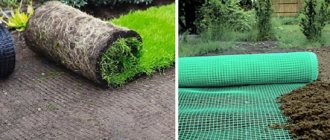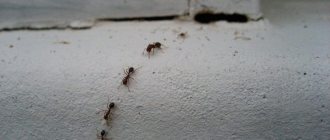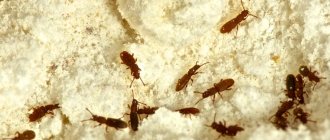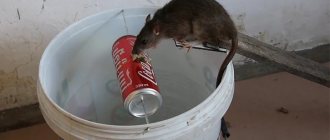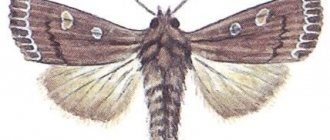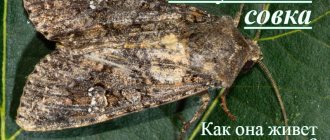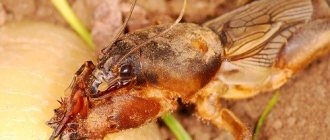There are many ways to fight moles. Some are designed only to catch animals, others are designed to immediately destroy them, and others are designed to ensure that the moles will leave the area on their own due to unfavorable conditions for them. We will tell you about the most effective methods.
A mole is an undeservedly offended creature. All sins are attributed to him that he did not commit. Root vegetables in the garden are gnawed - the mole is to blame! The roots of plants are gnawed - the work of a mole's hands (teeth)! The whole earth is up in arms - the mole has done a mischief again! But in reality, there is more than one mole operating in our gardens - there are several underground pest animals. And often it is they, and not the mole, who ruin our lives.
Who is causing us trouble and causing material damage? To understand this, you need to carefully study the traces of the “crime”. They will tell you who exactly came into our possessions.
What is the difference between a mole, a mole rat and a water vole?
At the summer cottage, three animals are engaged in underground “dirty tricks”: a mole, a mole rat and a water vole.
The water vole is better known as the water rat, or ground rat. Although in fact it is not a rat at all, but an animal of the Hamster family, because of their external similarity, the water vole is in everyday use called a rat. Often in the fall, during the preparation of supplies for the winter, this animal ends up in our gardens. That's when it starts to engage in sabotage. Root vegetables, tubers or plant bulbs that have been gnawed - the vole has worked with its teeth. If you notice that someone has gnawed the bark of seedlings or damaged the roots of trees, look for an earth rat in your possessions. Here and there mounds of earth appeared from underground passages - and here an earth rat could work.
The common mole rat is an animal from the order of rodents. Like the mole, the mole rat leads an underground lifestyle and, like the mole, has undeveloped eyes (hence the name of the animal). This is where the main similarities between the mole rat and the mole end.
The mole rat is a herbivorous animal. He happily eats plant roots, tubers and bulbs. It also loves above-ground parts: stems and leaves. The feeding passages of the mole rat are deeper than those of the mole - at a depth of 20-25 cm, while for the mole it is only 2-5 cm from the surface of the earth.
The mole, unlike the listed animals, does not feed on vegetation, because he is an insectivorous animal. Its main food is earthworms, so it is wrong to blame the gnawed crop on the mole. He is guilty only of spoiling the appearance of the lawn or area, and of touching the roots of plants while making moves. In other cases, you need to look for other culprits.
Electronic repellers
Hardware stores offer devices of varying power and, accordingly, operating area. Such equipment creates special vibrations that spread along the ground. The distance over which the action of repellent devices extends depends on the characteristics of the product of a particular manufacturer.
Often, owners of personal plots have to buy several electronic devices. The devices are installed at the very beginning of spring and are not dismantled until the end of the summer season.
Experienced users note that it is better not to install such devices in areas where cultivated plants are planted. This is due to the fact that at the very beginning of use, pests will show increased interest in the foreign structure. As a result, the number of soil mounds will increase, threatening the potential harvest.
About a month after installing electronic repellers, animals will gradually move to a distance of 10 meters or more from sources of unpleasant vibrations. Then the mammals will completely leave the area.
Acoustic equipment
Devices "Mole", "Mole" and other products can be purchased in specialized stores for gardeners and vegetable gardeners. The operating principle of such devices:
- the equipment creates ultrasonic waves that are similar to danger signals;
- moles cease to navigate in space.
The main advantage of this method is its safety. But an acoustic device is not enough for even the smallest garden plot. In addition, ultrasound creates discomfort for people and pets (cats, dogs, rabbits, etc.). The effect of using the device does not last long. If you turn it off, the moles will return and cause trouble again.
Plastic bottles from Andrey Berezin
Andrey Berezin used the most famous method of fighting moles - a homemade “noise maker”. To make it, take any plastic bottle and cut 3-5 “windows” on its side surface. Bend the cut plastic to one side. Now all that remains is to attach the noise repeller.
To do this, take a metal rod, and in the bottom of the bottle make a hole with a slightly larger diameter than the diameter of the rod (due to this size, the bottle will not be statically fixed, but will be able to “dangle” freely on the pole, which will create additional sounds). Fix the container on the rod and stick it next to the moles’ habitat. To be safe, make several of these pinwheels and place them every 10-15 m throughout the area.
The wind will create noise, the metal pin will transmit it to the ground. Moles don’t like such a noisy life, so they go to quieter neighbors. As soon as you notice the appearance of new individuals, repeat the procedure.
You can also use this version of the “noise maker”, as in the photo. In this case, the noise is created by rotating blades that are loosely attached to the neck of the bottle.
Mechanism of action
Chemical formula of phosphine
The action of Dakfosal is 2-stage. The original DV aluminum phosphide AlP is not a pesticide, but eagerly reacts with liquid and vapor moisture, forming phosphine gas (according to the new IUPAC chemical nomenclature - phosphane, formula in the figure):
AlP + 3H2O = Al(OH)3 + PH3
Phosphine is extremely poisonous and insidious: inhalation of air containing 1 mg/cubic meter for 10-15 minutes. m of phosphine, causes severe poisoning, but the characteristic smell of this gas is felt starting from a concentration of 2-3 mg/cu. m. The smell is unpleasant, but tolerable, and the certainly lethal concentration of phosphine in the air is 10 mg/cu. m. The primary symptoms of poisoning quickly pass, but within a period of 1 hour to a day it plays out in full force, and then medicine often turns out to be powerless - there is no antidote. One thing is gratifying in this case - phosphine, like phosgene, is unstable in the presence of atmospheric oxygen and over a certain time, depending on the conditions of use (see below), disintegrates without a trace into harmless components.
At the beginning of the last century, phosphine was tested as a more secretive asphyxiating agent (poisonous substance) instead of phosgene COCl2, the latter makes itself felt with a fairly strong smell of rotten hay before its content in the air reaches a lethal concentration. The asphyxiating mechanism of both agents is similar: they block the oxidation of hemoglobin in the blood. During experiments on convicts sentenced to death (at that time normal practice), the neurotoxic effect of phosphine was also revealed, which does not exclude long-term consequences of non-fatal poisoning with it.
Note: in the presence of very small amounts of carbon dioxide, the effect of phosphine on warm-blooded animals increases and becomes less predictable. But with a CO2 concentration in the air of 0.2% (stuffy, stuffy air in which it’s hard to breathe), the phosphine concentration is 1 mg/cu. m is already certainly fatal.
Phosphine did not become widespread in a total war due to its extremely high fire and explosion hazard - in air this substance is capable of spontaneous combustion. But in 1934, specialists from IG Farbenindustri (Germany) came up with a way to bind a “blank” of phosphine in tablet form. This made it possible to stabilize the flow rate of phosphine and at the same time reduce its concentration in the air of the room to a fire-safe level (subject to the conditions of use, see below). Since then, phosphine has been used for grain dressing and disinfestation/decarification of non-residential premises, and has recently found application in the open air as a remedy for moles and digging rodents.
Note: phosphine is the main financier of the so-called. wandering lights, which can occasionally be seen on a dark night in a cemetery. Will-o'-the-wisps above cattle burial grounds are generally a common occurrence. These, of course, are not the souls of the restless dead - phosphine is formed in quite significant quantities during the rotting of corpses in conditions of lack of air. If the burial conditions are such that methane is also formed (for example, in wet clay soils), then the spontaneous combustion of phosphine ignites the swamp gas, and then a much rarer phenomenon occurs - a pillar of fire. According to legends, this means that the deceased was a terrible sinner, no matter how righteous he may have seemed during life, and now the devils have dragged him to the underworld, and the fire that blazed over the grave is the hellish flame that escaped.
Using used cat litter to fight moles from Evgeniy Klyuev
In war, all means are good. Evgeniy Klyuev, for example, uses used cat litter (a good owner, as you know, never wastes anything, even used cat litter).
In a bucket of water, mix a lump of litter with cat waste. Fill the mole holes with the resulting solution, and then cover them with earth. Take a piece of reinforcement and use it to make many holes in the ground near the molehills. The animals will then move to a safe distance and stay away from your area.
Poisons and improvised means
Industrial enterprises produce chemical compounds that help get rid of moles. Many modern products meet safety requirements and cause almost no harm to the soil and plantings. However, care must be taken when using. Poisons can enter the body of an adult, child or pet and lead to irreversible consequences.
Under no circumstances should you try to create poison at home. Rat poison, as well as poisonous powders that quickly dissolve in water, will not work. After rain, chemicals will penetrate into the fertile layers of the soil.
A good solution would be to contact companies specializing in pest extermination. You will have to pay more for the services of professionals than for drugs in a store, but the effectiveness of this method is much higher.
Repellent home solutions
Summer residents often use castor oil. Mix 200 ml of castor oil and a few tablespoons of liquid soap. You can use dishwashing detergent. 15 ml of the resulting composition are dissolved in 2 liters of water. The solution is sprayed evenly over the entire treated area. It is better if the ground is damp. For this reason, it is recommended to carry out the procedure after watering or rain.
Other home remedies with strong odors will also help. You need to soak cloth or paper in them, and then put them in molehills. You should sprinkle some soil on top. For this purpose the following are used:
- petrol;
- kerosene;
- ammonia;
- valerian;
- naphthalene.
Shovel
This is the most important weapon of a summer resident, which is always nearby. Moles are eliminated from the site and remain alive, i.e. this is the most humane way. After rain, you need to trample down the raised molehills. The animal will definitely return and begin to restore them.
During the recovery process, the ground will begin to rise again. It is worth allowing the animal to restore a few meters of passages, and then begin to trample the soil sharply. The mole will return and begin to rebuild the tunnels again. It is important to seize the moment correctly, plunge the shovel deep into the ground and quickly remove the pest along with the soil layer. The mole should be placed in a deep container and taken to the forest. There it will eat insects and worms, so it will not harm the garden.
Hollow tubes
You can take a reed or reed trunk, as well as light pipes with a small diameter and a length of at least 2 m. The device is stuck into the hole. 50-60 cm of pipe should remain on the surface. In strong winds, air masses passing inside will create a hum. The hum scares off the moles, and they leave the area.
Ruthless fight against underground pests from Alexander Lisichkin
krot911.ru
Our reader Alexander Lisichkin decided to throw all his resources into the fight against moles. First, he suggests using noise repellers made from plastic bottles on poles. And for greater efficiency, at the same time, put dog excrement in the holes. If these methods are unsuccessful, you will have to move on to using traps.
There are two types of traps:
- Traps that kill animals.
- Live traps - in this case the mole will live. However, it is necessary to free the animal from the trap in time, because moles can survive without food for only 14 hours.
Alexander Lisichkin suggests building a live trap. To do this, take a plastic sewer pipe with a diameter of 50 mm. To make a trap, cut about half a meter of such pipe.
Now the entrances at both ends of the pipe need to be closed with “doors”. They can be made from the bottom and top of any tin can that is suitable in size. The height of the “door” should be approximately 5-6 mm larger than the hole, and the width, on the contrary, should be smaller.
Drill holes at the top, above the entrances, and secure the “doors” there with wire. Install them inside the pipe at a slight angle. Thanks to this trick, the mole will easily get inside the trap, but will not be able to get out of there: the “door” is larger than the hole, and the animal will not have enough strength to “open” it to the outside.
Dig up the mole passage and set a trap in the tunnel. The mole, walking through his labyrinths, should not suspect anything. Then he will calmly enter the pipe, but he will not be able to get out.
What plants do moles not like?
There are a number of different plants that give off an odor that moles don't like. Animals will not put up with such a “scent” and will certainly leave the cellar. Here is a short list of them:
Fritillaria. It is also popularly called the imperial hazel grouse. This is a very pretty, beautifully flowering bulbous plant grown in gardens as an ornamental crop. Fritillaria exudes a sharp, mole-frightening odor, which is in many ways reminiscent of the odor emanating from a fox.
The bulbs of this plant should be laid out in the cellar in sufficient quantities so that the smell is clearly felt. Moles will begin to think that a predator is nearby and will leave the dangerous place.
Castor bean fruits . They are somewhat toxic to moles and emit an unpleasant odor. Castor beans must be specially grown in the garden, then in the fall the ripened fruits are collected, which are used for pouring into cellar stocks.
Ruthless mole hunting from Nikolai
Nikolai suggests immediately starting to fight moles tooth and nail. And he suggests starting with traps. Dig up several mole holes and set traps in them. After that, cover everything again with soil.
If you find a passage that goes at an angle deep into the earth, Nikolai suggests filling it. Pour in kerosene. Thanks to its very strong and unpleasant smell, it will force moles to leave their homes and go “for permanent residence” to another area.
In addition to the above, many of our readers who have freed their territories from moles recommend getting a rat-catcher cat or hunting dogs: dachshund, spaniel, terrier, etc. These animals will forever relieve you of the worries of fighting moles and other pests.
Have you ever had to fight moles on your property? And who won?
Prevention
Given the characteristics of moles, it is much more difficult to get rid of them than from rodents or other pests, so it is recommended to follow preventive measures that can help prevent the likelihood of their appearance on the site:
- Installation of a fairly rigid and solid fence along the boundaries of the entire site; the material can be used linoleum , roofing felt, slate or ordinary metal mesh, which will need to be folded in several layers. The fence is buried in the ground, the height above the ground surface should be at least 50 cm, then the result will be a barrier that underground inhabitants will not be able to overcome.
- Planting onion plants and legumes on the site.
- Organization of ditches along the perimeter of the site, which are filled with gravel, crushed stone and coarse sand; these layers can be covered with ordinary soil on top. However, it is worth noting that if a mole is attracted to something on the site, then such a barrier will only delay it, but will not be able to stop it.
